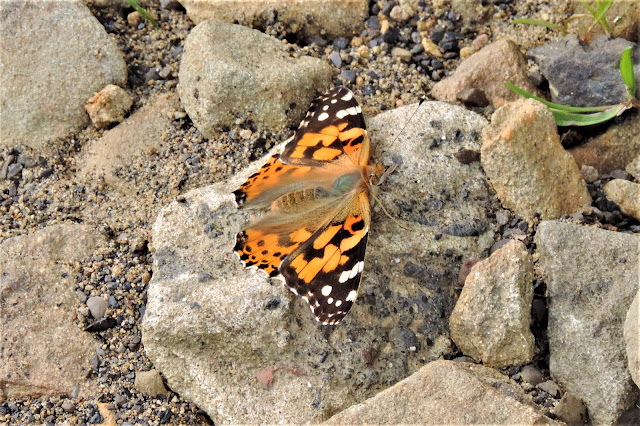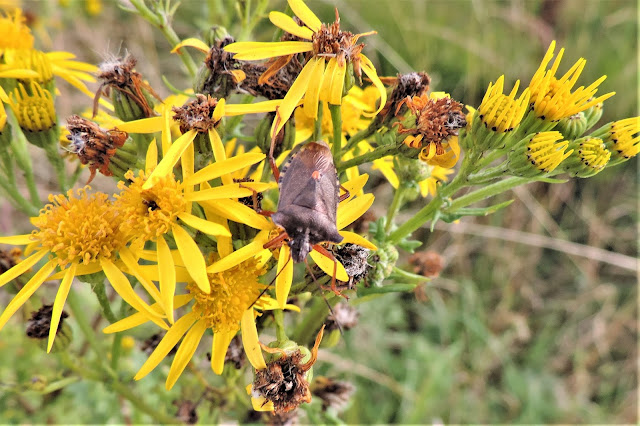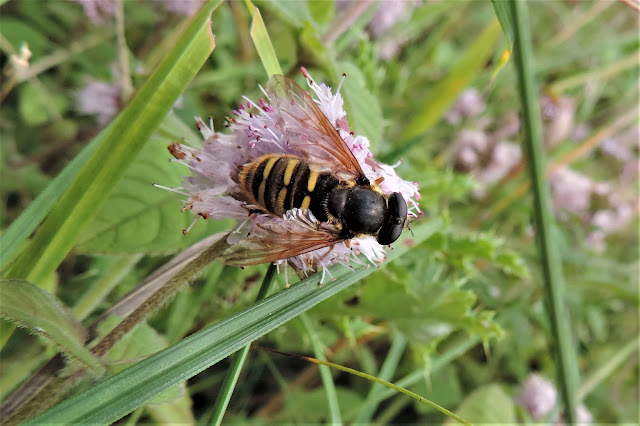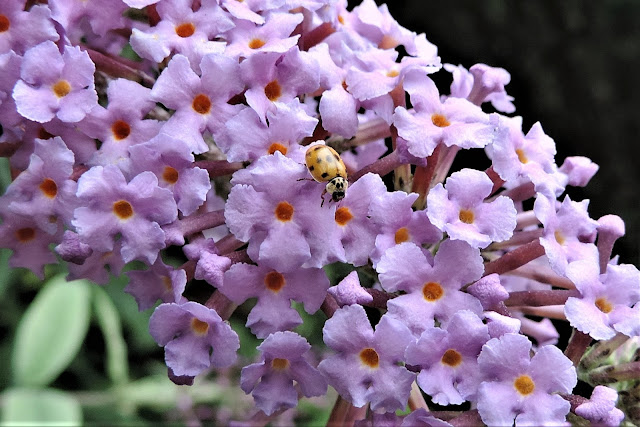With the hoverfly season starting to decline and new blooming flowers hard to come by at this time of year. I have to select areas with late blooming flowers such as Devilsbit Scabious, luckily Caerau has a large patch of this flower on the colliery spoil edge near the Newtown Bungalows and stream. So I spent 2hrs just in this patch which also has Heather, Goldenrod, Hemp Agrimony as supporting blooms. I recorded 21 species of hoverfly, amongst the commoner species were Melanostoma mellinum (1), Platycheirus granditarsus (1), Eupeodes corollae (1), Eupeodes latifasciatus (1), Eupeodes luniger (1), Helophilus pendulus (7), Helophilus trivittatus (1) and Sericomyia silentis (5). The most numerous hoverfly was Eristalis tenax (50) followed by Eristalis pertinax (20).
Butterflies also seem to like this patch and I recorded Painted Lady (1), Small Copper (5), Speckled Wood (5), Small White (1), Common Blue (1) and Small Heath (3). I also recorded 3 species of Shieldbug in Gorse Shieldbug, Red-legged Shieldbug and Tortoise Shieldbug, the latter I have no records of, so its new for me if not the valley.
Over the last few days there has been a Wryneck at Foel-y-Dyffryn, found and photographed by Colin Gittins. I've been up twice and missed it both times. The Wryneck is a rare and elusive passage migration species in Glamorgan with only a few records a year. I have added Colin's photo to the post for posterity. This bird is the 3rd record for the valley
Devilsbit Scabious patch
Eristalis tenax
Sericomyia silentis
Painted Lady
Tortoise Shieldbug
Gorse Shieldbug
Red-legged Shieldbug
White-crust Lichen on Larch, initially I thought someone had marked the tree for felling as it looked just like paint, but closer inspection showed it to be a lichen, I know nothing about lichen so I don't know the species, maybe Ispot can sort it out.
Wryneck - 3rd valley record, found and photographed by Colin Gittins at Foel-y-Dyffryn moorland on the 28th, also present on 29th.
Thursday, 30 August 2018
Monday, 27 August 2018
Garnwen
After a bright start to the day the weather quickly turned cloudy and cool with a stiff westerly, north-westerly wind. Not ideal conditions for insects, but the Angelica at Garnwen always delivers even on dank days like today. 21 species of hoverfly were seen with Eriozona syrphoides (rare) and Xanthogramma pedissequum (local) being the first of the year with a very late female Chrysogaster solstitialis a pleasant surprise. It is also good to see some species out in large numbers like Meliscaeva cinctella (220) and Eristalis pertinax (200), they have recovered well from the heatwave in July.
The only other family of insects of note were the Ladybird beetles, with 4 species present in good numbers and included Larch Ladybird, Harlequin Ladybird, 10-spot Ladybird and the common 7-spot Ladybird.
Eriozona Syrphoides (5th valley record)
Xanthogramma pedissequum
Chrysogaster solstitialis (my latest record by far)
Larch Ladybird
Harlequin Ladybird
The only other family of insects of note were the Ladybird beetles, with 4 species present in good numbers and included Larch Ladybird, Harlequin Ladybird, 10-spot Ladybird and the common 7-spot Ladybird.
Eriozona Syrphoides (5th valley record)
Xanthogramma pedissequum
Chrysogaster solstitialis (my latest record by far)
Larch Ladybird
Harlequin Ladybird
Sunday, 26 August 2018
Back to Spelter
A fine day for watching my son play Rugby, but made the effort to get up early (ish) so I could sneak in another two hours at Spelter Water Mint patch. 27 species of hoverfly species seen today, with most being the same species I saw a couple of days ago with the exception of Chrysotoxum bicinctum (1) and Cheilosia pagana (1) new for the site.
Other insects included 6 Small Tortoiseshell butterfly, a Triangle Plume moth, Tachina grossa and fera and 8 - 7-spot Ladybird. No birds of note this time. And by the way Glyncorrwg Rugby won again.
Sericomyia silentis
Sphaerophoria scripta
Triangle Plume
Tachina fera
Other insects included 6 Small Tortoiseshell butterfly, a Triangle Plume moth, Tachina grossa and fera and 8 - 7-spot Ladybird. No birds of note this time. And by the way Glyncorrwg Rugby won again.
Sericomyia silentis
Sphaerophoria scripta
Triangle Plume
Tachina fera
Tuesday, 21 August 2018
Spelter, Maesteg
After 4 days of mist and drizzle, this afternoon saw a break in the weather for an hour . So I shot off up to Spelter in the car and drove right up and parked next to the now in full flower Water Mint stream as last year it was a magnet for hoverflies. I went up a few weeks ago but then it was just starting to flower. The patch is only 15 yards long and 3 yards wide but is fly central for the area in August. I recorded 31 species of hoverfly just in that patch, which is an excellent count for this time of year. Highlights included first of the year Chrysotoxum festivum as well as 15 Platycheirus granditarsus, 3 Platycheirus rosarum, male Melanostoma Mellinum, 12 Eupeodes latifasciatus, male Dasysyrphus venustus, 4 Scaeva pyrastri, female Eristalis intricarius, male Helophilus hybridus, 2 Helophilus trivittatus and 2 Sericomyia silentis, Syritta pipiens were still out in large numbers (80) as was Eristalis tenax (65).
No other insects to talk off but surprisingly there was a small passage of waders overhead making use of the break in the weather. Oystercatcher (1), Eurasian Curlew (1) and Eurasian Golden Plover (24) all passed overhead flying down the valley [south].
small part of the mint patch that is a magnet for hoverflies.
Chrysotoxum festivum
Helophilus trivittatus
Platycheirus granditarsus
Small Copper
No other insects to talk off but surprisingly there was a small passage of waders overhead making use of the break in the weather. Oystercatcher (1), Eurasian Curlew (1) and Eurasian Golden Plover (24) all passed overhead flying down the valley [south].
small part of the mint patch that is a magnet for hoverflies.
Chrysotoxum festivum
Helophilus trivittatus
Platycheirus granditarsus
Small Copper
Friday, 17 August 2018
Gilfach (west), Top Llangynwyd
A cold, cloudy, windy day meant when I arrived I had little choice but to shelter from the wind by walking the forestry tracks. I was not expecting much and that's exactly what I got. Only 14 species of hoverfly recorded with nothing special, but it was nice to see Meliscaeva cinctella (26) and Meliscaeva auricollis (9) in fair numbers as they have been absent during the heatwave we just had.
Every cloud has a silver lining as they say. While looking at Angelica for hoverflies I noticed a small well marked moth on the next plant and it turned out to be Phaulernis fulviguttella, a Nationally Scarce B moth with only one previous record in Glamorgan, that being 2002 @ Afon Argoed (MJW) about 7kms away from where I was but the same mountain ridge. Only other insects of note were good numbers of 10-spot Ladybird and a Golden-ringed Dragonfly patrolling.
Phaulernis fulviguttella - above and below [new for valley, 2nd record for Glamorgan]
10-spot Ladybird
Eristalis pertinax
Eupeodes female - potted this one and it turned out to be the commonest species "corollae"
Every cloud has a silver lining as they say. While looking at Angelica for hoverflies I noticed a small well marked moth on the next plant and it turned out to be Phaulernis fulviguttella, a Nationally Scarce B moth with only one previous record in Glamorgan, that being 2002 @ Afon Argoed (MJW) about 7kms away from where I was but the same mountain ridge. Only other insects of note were good numbers of 10-spot Ladybird and a Golden-ringed Dragonfly patrolling.
Phaulernis fulviguttella - above and below [new for valley, 2nd record for Glamorgan]
10-spot Ladybird
Eristalis pertinax
Eupeodes female - potted this one and it turned out to be the commonest species "corollae"
Monday, 13 August 2018
Blaencaerau COP
After two days rain an excellent count of 37 species of hoverfly for August, plus a few specimens to determine later will add to the total. The late summer blooms of Hemp Agrimony, Devilsbit Scabious, Goldenrod, Fennel, Corn and Water Mint backed up by Angelica meant there was plenty of nectar about for hoverflies to feed particularly Water Mint that was covered in flies of all families. A good selection of highlights included Platycheirus peltatus, Chrysotoxum bicinctum, Epistrophe grossulariae, Eupeodes latifasciatus, Leucozona glaucia (scarce this year), Megasyrphus erraticus (2nd valley record), all 7 Eristalis including Eristalis intricarius and Eristalis rupium, all three Helophilus, Sericomyia silentis and a very late Volucella bombylans (plumata form).
Other flies included the Tachinids - Tachina grossa and fera, Eriorthrix rufomaculata and Thelaria nigripes. 9 species of butterfly were headed by 2nd generation Small Heath and Small Copper. Moths included 3 Silver Y, Ancylis badiana and Udea lutealis. The usual bees, wasps and beetles plus a female Common Darter Dragonfly. I also came across mutated acorns on Pendunculate Oak. These were made by the Knopper Gall Wasp (Andricus quercuscalicis) and is new for the valley.
Eristalis intricarius (female)
Helophilus trivittatus
Leucozona glaucia
Volucella bombylans - plumata form, a very late individual
Eriothrix rufomaculata
Meadow Grasshopper
Small Heath - 2nd generation
Mutated acorns of Pendunculate Oak, which is caused by a chemical reaction from the larva of the Knopper Gall Wasp. The wasp was introduced accidentally with imports in the late 1960's, since then it has spread throughout England and Wales and reached Ayrshire in Scotland by 2007. It causes serious damage to younger Oaks interfering with the reproductive cycle. A" Defra Plan" is being arranged to eradicate the wasp.
Other flies included the Tachinids - Tachina grossa and fera, Eriorthrix rufomaculata and Thelaria nigripes. 9 species of butterfly were headed by 2nd generation Small Heath and Small Copper. Moths included 3 Silver Y, Ancylis badiana and Udea lutealis. The usual bees, wasps and beetles plus a female Common Darter Dragonfly. I also came across mutated acorns on Pendunculate Oak. These were made by the Knopper Gall Wasp (Andricus quercuscalicis) and is new for the valley.
Eristalis intricarius (female)
Helophilus trivittatus
Leucozona glaucia
Volucella bombylans - plumata form, a very late individual
Eriothrix rufomaculata
Meadow Grasshopper
Small Heath - 2nd generation
Mutated acorns of Pendunculate Oak, which is caused by a chemical reaction from the larva of the Knopper Gall Wasp. The wasp was introduced accidentally with imports in the late 1960's, since then it has spread throughout England and Wales and reached Ayrshire in Scotland by 2007. It causes serious damage to younger Oaks interfering with the reproductive cycle. A" Defra Plan" is being arranged to eradicate the wasp.
Sunday, 12 August 2018
Tachind flies
As we have had 7" of rain in the last 2 days [not pleasant while driving back and forth to Gatwick (400miles)], there is no way to go out and look for hoverflies. When I'm out looking I always come across other families such as butterflies, bees, beetles etc. But one of the other fly families I usually see are Tachinidae flies known simply as Tachinids. There are 172 species on the family list I have found out, but many need to be caught and examined under magnification to determine the species. Conversely they also have some of the largest and most recognisable flies out there including Britain's biggest fly. I've managed to photograph ten of these species but know very little about their biology. So I decided to do a bit of reading on this family. What I learnt was pretty interesting. Tachinids are parasitiod flies rather than parasite flies, which means they lay their eggs in the host larva species and eat them alive, while parasite flies usually leave the host live. Most Tachinid species are specialist feeders on specific hosts within the butterfly, moths, beetle and bugs families. Identifying Tachinids is not easy as there are very closely related families in the fly group. Generally Tachinids have bristles on the body and have large squamae (fleshy flaps underneath the base of the wings), but the only true way to tell them from other close related families is that they have an enlarged sub-scutellum. This appears as a large fleshy bulge underneath the end of the scutellum when viewed from the side. Below are the ten Tachinids I have photographed with brief explanations on numbers seen, flight periods and hosts.
***** Paul Parsons and Paul Tabor have photographed other species of Tachinids that I have yet to see or photograph. *****
Dexiosoma caninum - 26 Jun - 2 Oct (11 records). Host - Common Cockchafer Bug.
Eriothrix rufomaculata - 21 Jul (1 record). Host - crambid grass moths especially Chrysoteuchia culmella.
Gonia picea - 27 Mar (1 record). Host - Noctuid moths especially Antler Moth and Square Spot Rustic.
Lophosia fasciata - 22 Aug - 30 Aug (5 records). Host - Shieldbugs especially Hawthorn Shieldbug.
Nowickia ferox - 04 Aug - 07 Sep (4 records). Host - Dark Arches Moth.
Phasia hemiptera - 26 Jun - 26 Aug (17 records). Host - Forest Bug in spring and Green Shieldbug in autumn.
Tachina fera - 06 Jun - 22 Sep (14 records). Host - Noctuid moths especially Broom, Dun-bar and Pine Beauty. This species is slightly different to other parasitiods because the adult lays its eggs on the foodplant of these moths and the larva wait for the unsuspecting moth larva to feed and then they eat their way in and when finished pupate.
Tachina grossa - 17 Jul - 09 Aug (13 records) Britain's largest fly. Host - hairy caterpillars especially Oak Eggar and Fox Moth.
Tachina ursina - 15 Mar (2 records). Host - unknown ?
Thelairia nigripes - 22 May - 24 Jul (40 records). Host - Garden Tiger Moth.
***** Paul Parsons and Paul Tabor have photographed other species of Tachinids that I have yet to see or photograph. *****
Dexiosoma caninum - 26 Jun - 2 Oct (11 records). Host - Common Cockchafer Bug.
Eriothrix rufomaculata - 21 Jul (1 record). Host - crambid grass moths especially Chrysoteuchia culmella.
Gonia picea - 27 Mar (1 record). Host - Noctuid moths especially Antler Moth and Square Spot Rustic.
Lophosia fasciata - 22 Aug - 30 Aug (5 records). Host - Shieldbugs especially Hawthorn Shieldbug.
Nowickia ferox - 04 Aug - 07 Sep (4 records). Host - Dark Arches Moth.
Phasia hemiptera - 26 Jun - 26 Aug (17 records). Host - Forest Bug in spring and Green Shieldbug in autumn.
Tachina fera - 06 Jun - 22 Sep (14 records). Host - Noctuid moths especially Broom, Dun-bar and Pine Beauty. This species is slightly different to other parasitiods because the adult lays its eggs on the foodplant of these moths and the larva wait for the unsuspecting moth larva to feed and then they eat their way in and when finished pupate.
Tachina grossa - 17 Jul - 09 Aug (13 records) Britain's largest fly. Host - hairy caterpillars especially Oak Eggar and Fox Moth.
Tachina ursina - 15 Mar (2 records). Host - unknown ?
Thelairia nigripes - 22 May - 24 Jul (40 records). Host - Garden Tiger Moth.
Saturday, 4 August 2018
Garnwen
Recorded a healthy 33 species of hoverfly even though it was 26c, highlights being Chrysotoxum arcuatum (3), 4 Eupeodes species including latifasciatus (3) and lapponicus (1), Melangyna compositarum/labiatarum agg (1)., Sphaerophoria philanthus (1 male) and Eristalis rupium (1).
Other insects included 10 species of Butterfly headed by Painted Lady and my first 2nd generation Dingy Skipper, all my other records are between 16 May and 22nd June. Other goodies included a Hummingbird Hawk-moth, Golden-ringed Dragonfly, longhorn beetle Stictoleptura rubra (male), Tachinid flies Norwickia ferox and Tachina grossa. Birds were notable by their absence.
Dingy Skipper - first 2nd generation record for me if not the valley.
Eristalis rupium - with its yellow first meta-tarsus
Eupeodes latifasciatus (male)
Hummingbird Hawk-moth - poor shot, wouldn't keep still
Norwickia ferox -interestingly this species lays its eggs in the Dark Arches moth and the larva eats it alive from within. The fly itself is quite rare and the valley seems to be a stronghold for the species.
Stictoleptura rubra (male) - another rare insect [longhorn beetle] with a stronghold in the valley. The larva feed in rotting wood, especially stacks of felled timber that are present in the forestry. They share this habitat with another longhorn beetle Rhagium bifasciatum, but they have different flight periods, with bifasciatum flying much earlier in the year and their flight period is well over when the rubra emerge. Although the larva can share the same log stack.
Other insects included 10 species of Butterfly headed by Painted Lady and my first 2nd generation Dingy Skipper, all my other records are between 16 May and 22nd June. Other goodies included a Hummingbird Hawk-moth, Golden-ringed Dragonfly, longhorn beetle Stictoleptura rubra (male), Tachinid flies Norwickia ferox and Tachina grossa. Birds were notable by their absence.
Dingy Skipper - first 2nd generation record for me if not the valley.
Eristalis rupium - with its yellow first meta-tarsus
Eupeodes latifasciatus (male)
Hummingbird Hawk-moth - poor shot, wouldn't keep still
Norwickia ferox -interestingly this species lays its eggs in the Dark Arches moth and the larva eats it alive from within. The fly itself is quite rare and the valley seems to be a stronghold for the species.
Stictoleptura rubra (male) - another rare insect [longhorn beetle] with a stronghold in the valley. The larva feed in rotting wood, especially stacks of felled timber that are present in the forestry. They share this habitat with another longhorn beetle Rhagium bifasciatum, but they have different flight periods, with bifasciatum flying much earlier in the year and their flight period is well over when the rubra emerge. Although the larva can share the same log stack.
Subscribe to:
Comments (Atom)



















































